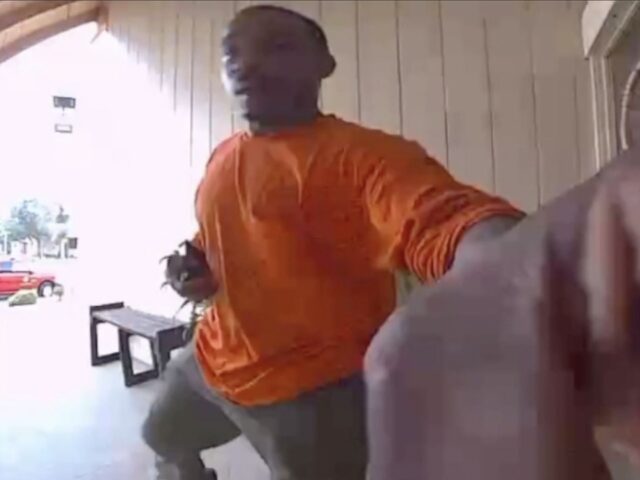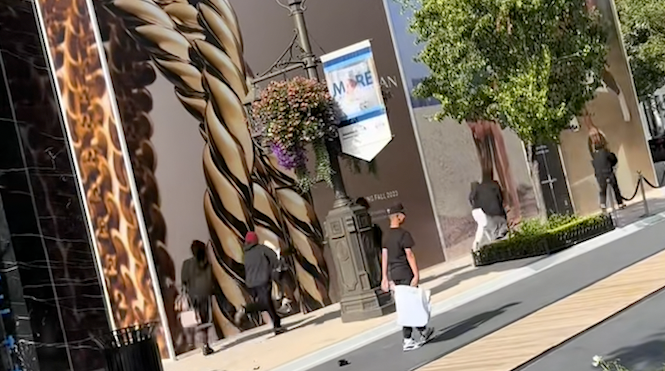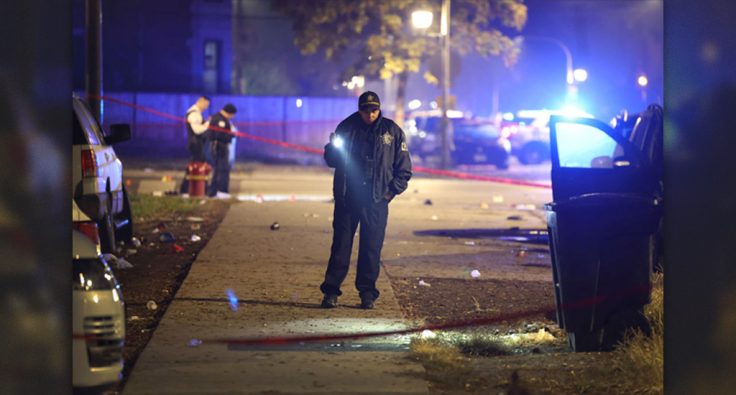Video shows suspects steal $300,000 worth of designer goods in 'flash mob burglary'
A high-end designer store in Glendale, California was looted by dozens of people in a flash mob burglary on Tuesday, Glendale Police said.
At least 30 suspects "flooded" the Yves Saint Laurent store in The Americana at Brand Tuesday afternoon and stole clothing and other merchandise before fleeing on foot and leaving the location in numerous vehicles, said police in a statement. An investigation into the incident is underway. The total loss is estimated to be approximately $300,000.
The Americana is a major indoor-outdoor hub in Glendale adjacent to Northeast and Downtown Los Angeles.
Video footage from the incident, captured by onlookers, shows dozens of masked individuals running out of the store with merchandise and other goods in their arms.
What is a 'flash mob' burglary?
"'Flash mob' burglaries involve a large, coordinated group of individuals simultaneously rushing into the store, overwhelming staff, and taking it over," explained the police, adding that suspects grab as much merchandise as they can before escaping in multiple vehicles.
More: Police arrest four accused of robbing Palm Desert mall jewelry store with sledgehammers
“This type of criminal activity will not be tolerated in Glendale," said Glendale Police Chief Manuel Cid in a statement, promising that the department will "pursue all leads and utilize every available resource to apprehend those responsible and bring them to justice."
Expect an elevated police presence in and around the downtown Glendale corridor, Cid added.
Caruso, the real estate company that owns The Americana at Brand is offering a reward of up to $50,000 for leads on the incident and suspects.
Glendale Mayor Dan Brotman also expressed concern over the event saying that “this coordinated crime challenges our values, but our determination to uphold safety and unity is resolute."
Anyone with information should contact the Glendale Police Department or the L.A. Regional Crime Stoppers, if they wish to remain anonymous.
Retailers concerned over organized theft
Meanwhile, retailers like Target, Walmart, Dollar General and Home Depot have expressed concern and are sounding the alarm on retail theft in recent months. Missing inventory was discussed more this past quarter than any quarter on record, according to data compiled by Bloomberg.
Retailers have been increasingly concerned about a loss of profits because of shrinkage – an industry term that refers to the difference between the inventory a store has on its balance sheet and its actual inventory.
Target CEO Brian Cornell shared that shrinkage can be driven by multiple factors. The term includes everything from items lost or damaged items to theft by employees or visitors. He and other executives have sounded the alarm over a rise in organized retail theft in which thieves steal merchandise to resell for a profit, often online through sites like Amazon or eBay.
To combat such incidents, retailers are introducing strategies like shorter store hours, self-servicing locking cabinets or smart shopping carts. However, there is also a worry that such measures will impact customer service and hurt sales. Some retailers have also been pushing for stricter penalties for stealing to curb retail theft.
However, before any strong conclusions can be drawn about the impact of retail theft on profit, more needs to be learned by greater data gathering and analysis.
This article originally appeared on USA TODAY: Dozens of suspects steal luxury designer goods in 'flash mob' robbery
WHILE WE'RE HERE, WHY NOT TALK ABOUT REPARATIONS FOR ALL VICTIMS OF BLACK VIOLENCE, CARJACKINGS, HOME INVASIONS AND STORE LOOTING.
CRIME IN AMERICA IS BLACK AND THIS IGNORANT WOMAN REMINDS US THAT BLACK AMERICA IS NEVER GOING TO HEAL ITSELF BECAUSE IT IS THE PROBLEM.
Only 'White People' Ever Enslaved Others, Says Black Professor
In a recent article, we considered the claims of Brittney Cooper, a professor at Rutgers University. She believes that all "white people," whom she also refers to as "m------------" who are "committed to being villains" — in a word, racists — need to be "taken out."
One of her arguments is that, whenever non-whites try to have a "reckoning" with whites, the latter say, "It's just human nature. If y'all had all of this power, you would have done the same thing," right?
To this, Cooper insists,
No, that's what white humans did, white human beings thought there's a world here and we own it. Prior to them, black and brown people have been sailing across oceans, interacting with each other for centuries without total subjugation, domination and colonialism, right?
This must be the professor's most ignorant of claims — which is saying much — that non-whites somehow behaved with more tolerance and civility whenever they landed on the shores of others.
While we don't necessarily have historical records of black sub-Saharans "sailing across oceans," we do know that they savagely warred on and enslaved one another. It is enough to point out that, as Michael Omolewa, a Nigerian diplomat, once did:
[T]he bulk of the supply [of African slaves sold to Europeans] came from the Nigerians. These Nigerian middlemen moved to the interior where they captured other Nigerians who belonged to other communities. ... Many Nigerian middlemen began to depend totally on the slave trade and neglected every other business and occupation. The result was that when the trade was abolished [by England in 1807] these Nigerians began to protest. As years went by and the trade collapsed such Nigerians lost their sources of income and became impoverished.
These are not just historical observations. Despite Western efforts to abolish slavery, there are currently more than 50 million slaves — all of them in the non-Western world. To quote from one report,
[a]s the world marks 400 years since the first recorded African slaves arrived in North America, slavery remains a modern-day scourge. ... Africa has the highest prevalence of slavery, with more than seven victims for every 1,000 people.
Even the overly romanticized American Indians engaged in "total subjugation and domination":
Long before Columbus, many historians agree that Native American tribes committed atrocities against each other, thirsting for power and land and killing anyone that stood in the way long before any European settler set foot on the continent.
More to the point, we have multiple examples of non-whites landing on the shores of whites — and centuries before the transatlantic slave trade began.
In 711, for example, hordes of African Muslims ("Moors," which came to mean dark-skinned or black Muslims) "godlessly invaded Spain to destroy it," to quote from the Chronicle of 754. They did not pass "a place without reducing it, and getting possession of its wealth," boasted al-Hakam, an early Muslim chronicler, "for Allah Almighty had struck with terror the hearts of the infidels." One year later, the Muslims had, the Chronicle of 754 continues, "ruined beautiful cities, burning them with fire; condemned lords and powerful men to the cross; and butchered youths and infants with the sword."
Several other early sources corroborate the devastation and persecution. The oldest account, the Tempore belli, tells of Muslims from Africa "sacking Christian temples [churches] and homes, burning the cities of those who resisted, and taking their young women as sexual slaves, all creating an indescribable terror."
In 715, after the Muslim conquest of Spain was complete, its generals made the long trip to the Umayyad caliphate in Damascus. They brought with them thousands of camels laden with immense treasures and thirty thousand captives as a flesh-tribute to Caliph Al-Walid, who, according to al-Maqqari the Arab chronicler, was delighted by "the resources of all the people of Spain ... its riches and the beauty of its young girls."
Thereafter, and because the "Umayyads particularly valued blond or red-haired Franc or Galician women as sexual slaves," writes historian Dario Fernandez-Morera, "al-Andalus [Muslim-controlled Spain] became a center for the trade and distribution of slaves [The Myth of the Andalusian Paradise, p. 159]." Christian subjects were sometimes even required to make an annual tribute "not of money, or horses, or arms, but of a hundred damsels (all to be distinguished for beauty) to ornament the harems [Spain and Portugal, p. 132]."
The Moorish conquest of Spain — and depredations deep into France, where tens of thousands of more Europeans were slaughtered and enslaved in the years leading up to the Battle of Tours, 732 — is just one example of what "black and brown people," to use Ms. Cooper's terminology, did to "white humans," centuries before the transatlantic slave trade.
One can give many more examples. Consider what the Turks, who migrated from the eastern steppes of Asia, did to and in Europe. In the years preceding the First Crusade, Turkish invaders were running amok in Asia Minor, formerly a bastion of Christianity (now "Turkey"). An anonymous Georgian chronicler wrote of how "holy churches served as stables for their horses," the "priests were immolated during the Holy Communion itself," the "virgins defiled, the youths circumcised, and the infants taken away." Similarly, Anna Comnena, the princess at Constantinople, wrote of how "cities were obliterated, lands were plundered, and the whole of Anatolia was stained with Christian blood."
Centuries later, in 1438, Bartolomeo de Giano, an Italian Franciscan who was holed up in Constantinople as the Turks laid siege to it, described their slave raids throughout the Balkans. From Hungary, 300,000 were enslaved and "carried off in just a few days," he wrote; from Serbia and Transylvania, 100,000 were "led away in iron fetters tied to the backs of horses ... [and] women and children were herded by dogs without any mercy or piety. If one of them slowed down, unable to walk further because of thirst or pain, O Good Jesus! she immediately ended her life there in torment, cut in half."
As one historian observes, "[t]he massive enslavement of slavic populations during this period gave rise, in fact, to our word 'slave': in Bartolomeo's time, to be a slave was to be a Slav."
The slave markets of the Ottoman sultanate were for centuries so inundated with European flesh that children sold for pennies, "a very beautiful slave woman was exchanged for a pair of boots, and four Serbian slaves were traded for a horse."
It was the same elsewhere. In Crimea — where many millions of Slavs were enslaved by the Ottomans' Muslim allies, the Tatars (Mongols turned Muslim) — an eyewitness described how Christian men were castrated and savagely tortured (including by gouging out their eyes), whereas "[t]he youngest women are kept for wanton pleasures."
As for the Moors, even after being ejected out of Spain and back to North Africa (or Barbary), they continued raiding virtually every corner of Europe — going as far as Britain, Ireland, Denmark, and Iceland in search of plunder and slaves. These raids were so successful that, "between 1530 and 1780[,] there were almost certainly a million and quite possibly as many as a million and a quarter white, European Christians enslaved by the Muslims of the Barbary Coast," to quote American historian Robert Davis.
With countless European women selling for the "price of an onion," little wonder that by the late 1700s, European observers noted how "the inhabitants of Algiers have a rather white complexion."
Then there was the abysmal treatment meted out to European slaves. As Robert Playfair (b.1828), who served for years as a consul in Barbary, explained, "[i]n almost every case they [European slaves] were hated on account of their religion." Three centuries earlier, John Foxe (b.1516) had written in his Book of Martyrs that "[i]n no part of the globe are Christians so hated, or treated with such severity, as at Algiers."
The punishments these European slaves received for real or imagined offenses beggared description:
If they speak against Mahomet [blasphemy], they must become Mahometans, or be impaled alive. If they profess Christianity again, after having changed to the Mahometan persuasion, they are roasted alive [as apostates], or thrown from the city walls, and caught upon large sharp hooks, on which they hang till they expire.
These are just a very few examples to counter Professor Cooper's assertion:
Prior to them [whites], black and brown people have been sailing across oceans, interacting with each other for centuries without total subjugation, domination and colonialism, right?
Wrong — abysmally so.
Raymond Ibrahim, author of Defenders of the West and Sword and Scimitar, is the Distinguished Senior Shillman Fellow at the Gatestone Institute and the Judith Rosen Friedman Fellow at the Middle East Forum.

Image via Picryl.
Suspect in Critical Condition After Resident Opens Fire to Save Family

A Bakersfield, California, intruder was shot by a resident and hospitalized in critical condition after allegedly forcing his way into a home around 8 p.m. last Friday.
Video from a Ring camera showed the suspect, 38-year-old Tanarri Stocker, who was allegedly armed, ringing a doorbell at one house then running to a neighboring house. It was at the neighboring home that the Stocker allegedly made unwanted entry and came face-to-face with a legal gun owner.
KGET reported Stocker allegedly entered via the garage then went into the home through a side door. A resident in the home shot Stocker, critically wounding him.
The Bakersfield Police Department indicated Stocker “is a convicted felon and prohibited from possessing a firearm.” The charges arising from Friday’s incident include aggravated assault and being a felon in possession of a firearm,
AWR Hawkins is an award-winning Second Amendment columnist for Breitbart News and the writer/curator of Down Range with AWR Hawkins, a weekly newsletter focused on all things Second Amendment, also for Breitbart News. He is the political analyst for Armed American Radio and a Turning Point USA Ambassador. He was a Visiting Fellow at the Russell Kirk Center for Cultural Renewal in 2010, a speaker at the 2023 Western Conservative Summit, and he holds a Ph.D. in Military History, with a focus on the Vietnam War (brown water navy), U.S. Navy since Inception, the Civil War, and Early Modern Europe. Follow him on Instagram: @awr_hawkins. You can sign up to get Down Range at breitbart.com/downrange. Reach him directly at awrhawkins@breitbart.com.
The Oakland NAACP released a statement Thursday calling for state and local elected leaders to declare a "state of emergency" as a result of increasing violent crime in the California city.
The statement, written by Oakland NAACP president Cynthia Adams and Bishop Bob Jackson of Acts Full Gospel Church, blasted soft-on-crime local officials as well as left-wing activism for the surge in crime.
"Failed leadership, including the movement to defund the police, our District Attorney’s unwillingness to charge and prosecute people who murder and commit life threatening serious crimes, and the proliferation of anti-police rhetoric have created a heyday for Oakland criminals," Adams and Jackson wrote.
Adams and Jackson also said that African Americans were disproportionately affected by crime and criticized misguided attempts to alleviate racism by refusing to prosecute violent offenders.
"There is nothing compassionate or progressive about allowing criminal behavior to fester and rob Oakland residents of their basic rights to public safety. It is not racist or unkind to want to be safe from crime," the statement read.
Adams and Jackson called on city and state officials to devote additional resources, including police officers, to resolve the problem:
"We are in crisis and elected leaders must declare a state of emergency and bring resources together from the city, the county, and the state to end the crisis."
The statement comes amid a spike in crime in the Bay Area. In neighboring San Francisco, Mayor London Breed was forced to flee a speech on combating violent crime after someone threw a brick in the crowd.
Several big-name brands like Nordstrom and Saks OFF 5th and hotel chains have left the area due to concerns about public safety.
Gun-Controlled Washington, DC, on Pace for Deadliest Year in 2 Decades

Gun-controlled, Democrat-run Washington, DC, is witnessing a surge in murders that is putting it on pace to record its deadliest year in two decades.
Three homicides over the weekend brought the city’s total for this year to 161, which represents “a 28 percent increase over this time in 2022,” the Washington Post noted.
Jamila White chairs the Advisory Neighborhood Commission for the area in which the latest three murders occurred and claims city officials are not responding to the commission’s suggestions on how to fix things.
White said, “Our voices and our solutions are not being acted upon. The community has been doing what it can. The community is in survival mode.”
The DCist reported on August 2 that U.S. Attorney for D.C. Matthew Graves, a Biden appointee, assured the city’s residents his office is working with police to focus on a small group of people who they believe are behind the killing and mayhem.
The outlet pointed to “a 2022 study…[which] found that as few as 500 identifiable people, many of them involved in neighborhood crews or cliques, are responsible for 70% of the city’s shootings.” That small group comprises those on whom Graves is focused.
Gabby Giffords’ gun control group, Giffords, points out Washington, DC, has universal background checks, gun owner licensing, a red flag law, an “assault weapons” ban, a “high capacity” magazine ban, firearm registration, waiting periods for gun purchases, gun storage laws, and many other gun controls.
These same controls have also failed to stop shootings in California.
AWR Hawkins is an award-winning Second Amendment columnist for Breitbart News and the writer/curator of Down Range with AWR Hawkins, a weekly newsletter focused on all things Second Amendment, also for Breitbart News. He is the political analyst for Armed American Radio and a Turning Point USA Ambassador. He was a Visiting Fellow at the Russell Kirk Center for Cultural Renewal in 2010, a speaker at the 2023 Western Conservative Summit, and he holds a Ph.D. in Military History, with a focus on the Vietnam War (brown water navy), U.S. Navy since Inception, the Civil War, and Early Modern Europe. Follow him on Instagram: @awr_hawkins. You can sign up to get Down Range at breitbart.com/downrange. Reach him directly at awrhawkins@breitbart.com.

